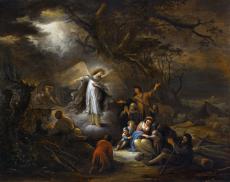


The announcement of the birth of Jesus to the shepherds is recounted in the Gospel of St Luke 2:8-11: ‘Now there were in the same country shepherds living out in the fields, keeping watch over their flock by night. And behold, an angel of the Lord stood before them, and the glory of the Lord shone around them, and they were greatly afraid. Then the angel said to them, “Do not be afraid, for behold, I bring you good tidings of great joy which will be to all people. For there is born to you this day in the city of David a Saviour, who is Christ the Lord.”’ Jacob de Wet, whose signature can be found on the tree trunk at the bottom right of this painting, obviously based himself on this text, because both the setting at night and the fear among the shepherds with the sudden appearance of the angel in a clear light from above are rendered according to the Gospel.
The Annunciation to the Shepherds was inspired by an etching by Rembrandt of 1634, The Angel Appearing to the Shepherds. The angel, who appears to the left of the group of shepherds, and especially the setting under a group of trees were derived from Rembrandt’s model. De Wet has adapted Rembrandt’s vertical composition to a horizontal format, just like, for example, Govaert Flinck did with his large version of the Annunciation to the Shepherds of 1639 in the Musée du Louvre. De Wet has long been recorded as one of Rembrandt’s pupils, though he actually never was. Dating works by de Wet can be difficult. In this case, the borrowing from Rembrandt’s etching gives us a terminus post quem of 1634, and the date can be narrowed even further, because de Wet made a drawing with the same subject in a sketchbook that he used between 1638 and 1670.
In simple contour lines in pen and brown ink, the artist made a charming summary ‘statement’ of the composition. Sumowski called this technique ‘without parallel in the drawings of this artist’. This sheet is the only known drawing that can be related to a painting by the master. The figure lying down at the bottom right in both the drawing and the painting makes this relationship especially explicit. Judging the character of the drawing, we may also assume that the artist made it intentionally as a study for the painting; the sheet is therefore a modello and not a ricordo. This makes the A. G. Leventis Collection Annunciation relatively special in de Wet’s oeuvre. Jacob de Wet, a native of Haarlem, was born around 1610, the son of Willem de Wet, the Catholic bailiff of the Public Revenue. Jacob had a brother, Gerrit, who was active as a painter in Haarlem and Leiden, where he died in 1674. We have no information about Jacob’s training, but in 1632 he joined the Haarlem painters’ guild. His earliest known work dates to the same year. He is mentioned in the records of Haarlem fairly often from 1635 up to 1675. In 1637, he registered in Alkmaar, possibly to escape the plague in Haarlem. In 1677, he registered as a member of the painters’ guild in Cologne.
He must have died between this year and 1691, because in April of that latter year his children sold his house in Haarlem. His pictures are almost all religious and mythological subjects, often in a landscape setting. Their style makes clear that he was a dedicated follower of Rembrandt. Very occasionally de Wet painted pure landscapes, and in his sketchbook there are drawings of views around Haarlem. His son Jacob de Wet the Younger (1641/2-1697) at first imitated him closely.
Nothing is documented about his training, but in 1632 he joined the painters’ guild in Haarlem, where he appears to have run a successful studio. His paintings are mostly religious and mythological subjects, often in a landscape setting, in a manner clearly influenced by Rembrandt.